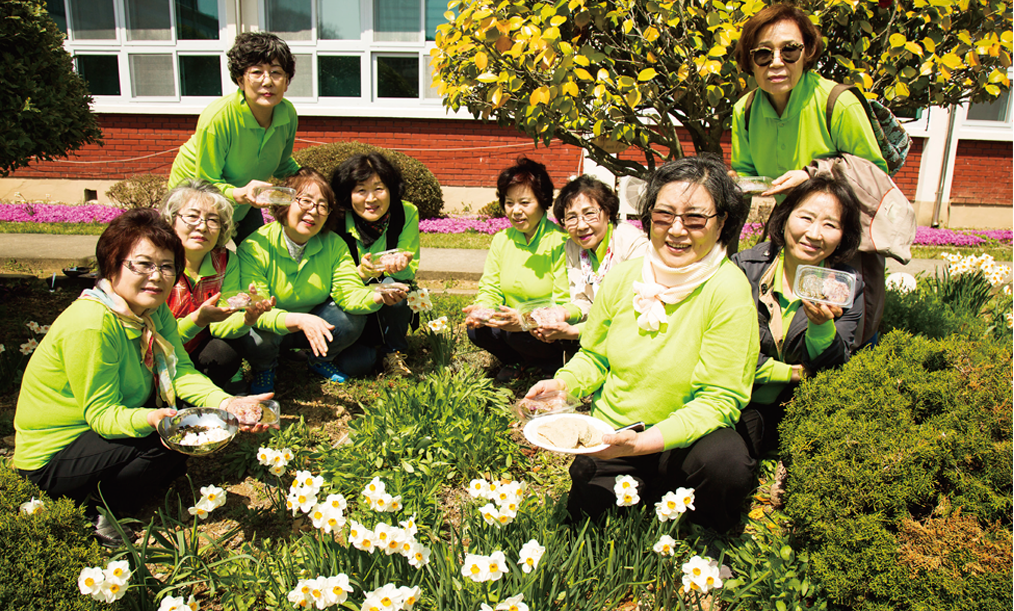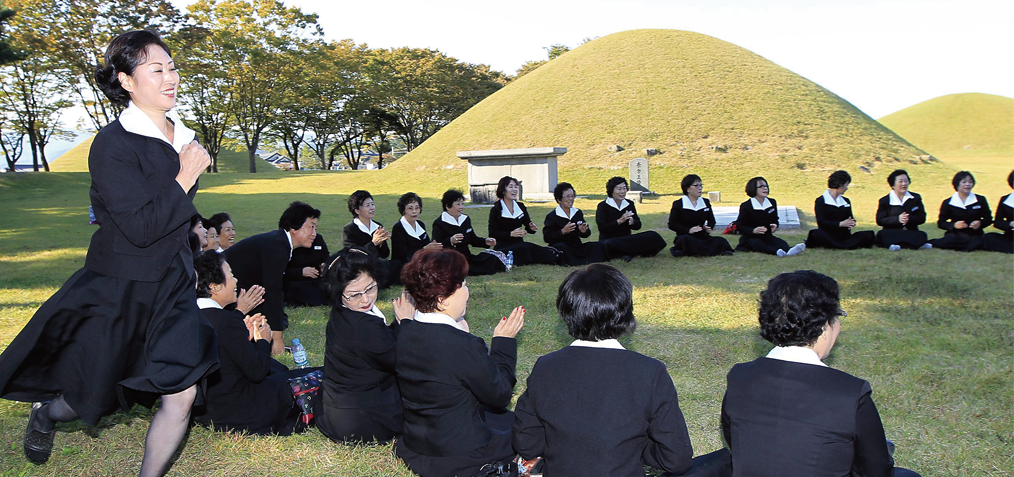It has been more than 130 years since Korean girls and women started to acquire formal education withthe introduction of the Western school system in the country. Women have since made their way intothe public sphere, but for many a high school reunion still remains a rare opportunity after school andmarriage to get in touch with the world outside of family and in-laws.
The high school years arerecalled by many as their mostmemorable time in school. Forwomen who went to school at a timewhen girls and boys were strictly segregated,the connection with theirfriends from that period is very specialand continues long after graduation,kept ever fresh by regular reunions.Between these gatherings, sweetmemories of youthful friendships arekept alive by the songs of their youthlike “The jeweled wings of dreams,” orthe bittersweet refrain at graduation time, “The time of farewell hascome, good-bye, wish you good luck, good-bye, friends....”
Address Book Five Years in the Making
Son Hei-young, a graduate of Ewha Girls’ High School, the oldestschool for women in Korea, recalled the time when her schoolmatesstarted having reunions. “In the 1960s, when we graduatedfrom high school, we had a new world unfolding before each of us,so the alumnae did not stick together much. After about 20 years, we had established our lives to certaindegrees and wanted to see old friends,so about ten of us, [who were] easy tocontact, started to meet once a month.It took us five years to complete theaddress book of about 400 alumnae.We then published a newsletter,held events for the 30th, 40th, and50th anniversaries of our graduation,and organized small hobby groupsfor sports, choir singing, painting, andother leisure activities.”
Activities at reunions are generallysimilar no matter what school the women attended.
Small groupsmeet regularly in each local area, and sometimes, a bigger officialevent is organized for a reunion of the entire class.Regardless ofthe size of the get-together, the participants enjoy themselves talkingand eating together, taking in a lecture, playing sports, dancingand singing, traveling, or doing something for the alma mater. Forthe special events, mostly held in rented hotel ballrooms, they practicedancing and singing in advance. Everyone says they don’t feelawkward doing these things together, even though they might not have seen each other for a long time; surely this is due to the welltendedmemory of their old friendships.

Azalea pancakes, an earlyspringdelicacy made withsticky rice dough mixed withpink azalea petals and friedin oil, have become a specialtreat identified with the annualreunion of graduates ofTongyeong Girls’ High Schoolin Tongyeong, South GyeongsangProvince, where thespring flowers blossom earlierthan anywhere in Korea.The school’s alumnae fromvarious parts of the countrygather at the school groundsto share the delicacy theymade together and to renewtheir friendship.
Friendship Contained in Hometown Delicacies
Graduates of Tongyeong Girls’ High School, located in Tongyeong,a port city in South Gyeongsang Province, maintain a special traditionfor their reunions. Every year on April 9, the school’s foundinganniversary, they gather to cook azalea pancakes and mugwort ricecakes to be served and given as gifts.
Alumna Lee Jeong-yeon explained, “Around that time, theTongyeong Market becomes a flower market. Before the reunion,hometown alumnae make the preparations as hosts of the gathering.They are joined by other alumnae who arrange to arrive aheadof the event. Together, they go to the market, buy azalea blossomsand glutinous rice for the dough and make the pancakes; they alsomake crescent-shaped mugwort rice cakes from a mixture of freshmugwort and rice flour. We are grateful to the reunion committee,which prepares these delicacies every year.”
Village people living in nearby mountains pick the azalea flowers,take out the poisonous stamens, carry the remainder by the basketful,and sell them in the market. The alumnae buy them and mixso many of them with sticky rice dough that the dough is hardly visible.The small pancakes, baked shortlybefore eating, resemble pink flowers inbloom. In Tongyeong, every family preparesand enjoys this specialty in thespring.
Bae Do-su, president of the alumnaeassociation of Tongyeong Girls’High School, said, “Preparing this delicacyrequires a lot of work, and theexpense incurred in serving severalhundred people is not low, but we gladlydo it every time because they come,some from far away, with the expectationof enjoying these hometown delicacies.We want to relive the memoryof enjoying them together as we did in the past.” She added, “Wealso give out some flower dough as a gift.”
In Kaesong, now in North Korea, people would make soup forthe Lunar New Year’s Day with joraeng-i tteok, small pieces of ricecake pressed in the middle with a bamboo stick to form a figure 8 orthe shape of an unshelled peanut. The soup is prepared for ancestralrites and is shared with family members afterward. Kaesongnatives have kept their traditional cuisine even after leaving theirhometown and settling in the South. Graduates of Kaesong’sHolston Girls’ High School gather together the day before the LunarNew Year and make these rice cakes to send to friends and kin asa gift. This tradition has been passed on to younger generations,including their daughters-in-law.
Some alumnae living in Seoul meet together more often, sustainingtheir friendships through different personal traditions. ForLee He-suk, who lives in a house with a big yard, making soy sauceusing fermented soybeans together with friends from her elementary,middle, and high school years, is an annual event full of meaning.About two months later, they can all take home a pot of theirvery own soy sauce. Cheon Yi-hyang, president of the alumnaeassociation of Pungmun Girls’ High School, and her fellow alumnae,her friends of 40 years, make mandu [dumplings] at home forthose who have difficulty going out for the year-end party. Everyonebrings one of the ingredients; they exchange gifts and enjoy chattingand sharing jokes like the young girls they were long ago. The giftsrange from rice cakes, pretty dishware, or fine soaps, thoughtfullyplanned to avoid clutter at home. Those who take phone calls duringthe gathering have to pay a penalty.
Lee Sun and her school friends of 30 years meet once a monthat the Sindorim subway station in southwestern Seoul. The meetingplace was chosen for the convenience of those coming from otherprovinces. From there, they move to a nearby shopping mall forlunch. Chatting and discussing issues before them, and sometimeswatching a movie, they spend an entire day together.
Using Social Media for Reunions
There are always some who are very good at housekeeping.From know-how on its trivial aspects to the secrets of smartinvesting, they exchange information on various topics. There alsoare always a couple of people expressing strong political opinions,which sometimes leads to awkward moments, but eventually,the moments pass and the discussions move on. One benefit ofreunions is that they provide a chance to do some voluntary work.Members take on chores in turns, such as planning a trip or meeting,preparing necessary materials, sending out letters and messages,or keeping the accounts. As alumnae get older, they collectjust enough money from members for occasional expenses. Usually,a monthly contribution of 30,000 won (approximately 30 dollars)will cover lunch and other costs, such as helping out on familyevents of the members.
In group photographs of 30-year reunions, alumnae often sit or stand straight in formal poses. Theposes on photos of 40-year reunions are somewhat freer, with some half-reclining and relaxed,all smiling brightly. The parties often taking place for 50-year reunions represent the peak of thistradition.
The smartphone has also changed how reunions get organized.The current trend is to contact each other through group chatrooms. The old method of sending out newsletters by snail mail isnow passé. About 10 years ago, internet cafés were dominant, butfor a few years now, instant messaging apps are the main means ofcommunication.
Through the smartphone, distances between friends from aroundKorea and overseas disappear as messages are exchanged instantlyand 24/7. The downside of those apps is that engaging in too manychat rooms at a time can feel like swimming in a sea of spam, forcingone to decide what to do with the flood of messages. What’smore, by participating in numerous chat rooms, people sometimesbecome confused and send messages to the wrong one, thus unintentionallyrevealing private matters to the wrong person. Therefore,one needs a fair amount of social media skills when using alumnaechat rooms. Due to their convenience, as well as the curiosity of themembers, social media were more actively used at first, but nowmore and more alumnae leave chat rooms to keep their daily livesmore relaxed.
The Sunset of a Sweet Tradition
Inevitably, alumnae reunions also mark the passage of time. Ingroup photographs of 30-year reunions, alumnae often sit or standstraight in formal poses. The poses on photos of 40-year reunionsare somewhat freer, with some half-reclining and relaxed, all smilingbrightly. The parties often taking place for 50-year reunionsrepresent the peak of this tradition. Alumnae join from all over theworld, dressed up for the special occasion. Contributions to theiralma mater, such as scholarships, become bigger, and many boasttheir previously hidden talents in various performances during thegathering.

Friends since their youthful years, the women, now in middle age, revisit Gyeongju,the capital of the ancient Silla Kingdom and a memorable destination of their highschool field trips. With memories of such a trip ever fresh, they play a “drop the handkerchief”game in the grass lawn near a royal tomb. Attired in their school uniform,their faces reflect the joy of reliving a memory from their school years.
Fifty years of friendship are celebrated in other ways, too. Somealumnae groups have published books recording their activities andtime spent together. The 1965 graduates of Ewha Girls’ High School,for example, collected 300 photos of alumnae from 1946 to 2015and published a photo essay book titled “Fashion History of ModernKorean Women 1946–2015.” It traces modern Korean women’saesthetic sense during the country’s rapid industrial and socialdevelopment, not through fashionable dresses worn by models andprofessional women but through the daily clothing of housewives,featuring some memories about famous fashion designers asbackdrops.
There are certainly 60-year reunions, too, but as people get older,fewer of them can muster the energy required to organize them.By the age of 80, people often have trouble getting around due toarthritis, while others are bedridden, rendering reunions nearlyimpossible. And so, girls’ high school reunions draw to their closeand the joys of friendships formed in youthful days slowly fade intodistant memories.